
Asteraceae is a large family of flowering plants that consists of over 32,000 known species in over 1,900 genera within the order Asterales. The number of species in Asteraceae is rivaled only by the Orchidaceae, and which is the larger family is unclear as the quantity of extant species in each family is unknown. The Asteraceae were first described in the year 1740 and given the original name Compositae. The family is commonly known as the aster, daisy, composite, or sunflower family.

Zinnia is a genus of plants of the tribe Heliantheae within the family Asteraceae. They are native to scrub and dry grassland in an area stretching from the Southwestern United States to South America, with a centre of diversity in Mexico. Members of the genus are notable for their solitary long-stemmed 12 petal flowers that come in a variety of bright colors. The genus name honors the German scientist Johann Gottfried Zinn (1727–1759).

Osteospermum, is a genus of flowering plants belonging to the Calenduleae, one of the smaller tribes of the sunflower/daisy family Asteraceae. They are known as the daisybushes or African daisies. Its species have been given several common names, including African daisy, South African daisy, Cape daisy and blue-eyed daisy.

Gundelia or tumble thistle is a low to high (20–100 cm) thistle-like perennial herbaceous plant with latex, spiny compound inflorescences, reminiscent of teasles and eryngos, that contain cream, yellow, greenish, pink, purple or redish-purple disk florets. It is assigned to the family Asteraceae. Flowers can be found from February to May. The stems of this plant dry-out when the seeds are ripe and break free from the underground root, and are then blown away like a tumbleweed, thus spreading the seeds effectively over large areas with little standing vegetation. This plant is native to the eastern Mediterranean and the Middle-East. Opinions differ about the number of species in Gundelia. Sometimes the genus is regarded monotypic, Gundelia tournefortii being a species with a large variability, but other authors distinguish up to nine species, differing in floret color and pubescence. Young stems are cooked and eaten in the Middle-East and are said to taste like a combination of artichoke and asparagus.

In botany, a bract is a modified or specialized leaf, especially one associated with a reproductive structure such as a flower, inflorescence axis, or cone scale.

Symphyotrichum novae-angliae is a species of flowering plant in the aster family (Asteraceae) native to central and eastern North America. Commonly known as New England aster, hairy Michaelmas-daisy, or Michaelmas daisy, it is a perennial, herbaceous plant usually between 30 and 120 centimeters tall and 60 to 90 cm wide.

Bellis perennis, the daisy, is a European species of the family Asteraceae, often considered the archetypal species of the name daisy. To distinguish this species from other plants known as daisies, it is sometimes qualified or known as common daisy, lawn daisy or English daisy.

Gerbera L. is a genus of plants in the Asteraceae (Compositae) family. The first scientific description of a Gerbera was made by J. D. Hooker in Curtis's Botanical Magazine in 1889 when he described Gerbera jamesonii, a South African species also known as Transvaal daisy or Barberton daisy. Gerbera is also commonly known as the African daisy.

Leucanthemum × superbum, the Shasta daisy, is a commonly grown flowering herbaceous perennial plant with the classic daisy appearance of white petals around a yellow disc, similar to the oxeye daisy Leucanthemum vulgareLam, but larger.

Symphyotrichum is a genus of over 100 species and naturally occurring hybrids of herbaceous annual and perennial plants in the composite family, Asteraceae, most which were formerly treated within the genus Aster. The majority are endemic to North America, but several also occur in the West Indies, Central and South America, as well as one species in eastern Eurasia. Several species have been introduced to Europe as garden specimens, most notably New England aster and New York aster.

A pseudanthium is an inflorescence that resembles a flower. The word is sometimes used for other structures that are neither a true flower nor a true inflorescence. Examples of pseudanthia include flower heads, composite flowers, or capitula, which are special types of inflorescences in which anything from a small cluster to hundreds or sometimes thousands of flowers are grouped together to form a single flower-like structure. Pseudanthia take various forms. The real flowers are generally small and often greatly reduced, but the pseudanthium itself can sometimes be quite large.

Symphyotrichum lateriflorum is a species of flowering plant in the aster family (Asteraceae). Commonly known as calico aster, starved aster, and white woodland aster, it is native to eastern and central North America. It is a perennial and herbaceous plant that may reach heights up to 120 centimeters and widths up to 30 centimeters.

Chaenactis artemisiifolia, with the common name white pincushion, is a species of flowering plant in the daisy family. It is native to the coastal Peninsular Ranges of Southern California and Baja California, in the chaparral and woodlands.

Olearia floribunda, commonly known as heath daisy-bush, is a species of flowering plant in the family Asteraceae and is endemic to south-eastern Australia. It is an upright, spreading shrub with egg-shaped leaves and white and yellow or mauve, daisy-like inflorescences.

The Stifftioideae are a subfamily of the family Asteraceae family of flowering plants. It comprises a single tribe, Stifftieae, of ten genera.

Chrysanthemum × morifolium (also known in the US as florist's daisy and hardy garden mum, is a hybrid species of perennial plant in the genus Chrysanthemum of the Asteraceae family.

Symphyotrichum dumosum is a species of flowering plant of the family Asteraceae commonly known as rice button aster and bushy aster. It is native to much of eastern and central North America, as well as Haiti and Dominican Republic. It is a perennial, herbaceous plant that may reach a height of 1 meter.

Garden marguerites, also known as marguerite daisies, are cultivars of plants in the subtribe Glebionidinae of the family Asteraceae, the great majority being hybrids created in cultivation. One of the genera belonging to the subtribe, Argyranthemum, was introduced into cultivation from the Canary Islands in the 18th century, and modern cultivars are mostly sold and grown under the genus name Argyranthemum or the species name Argyranthemum frutescens, although many are actually intergeneric hybrids. The first such hybrids involved species now placed in the genus Glebionis, but other crosses within the subtribe are known. Breeding has aimed at introducing flower heads in varied colours and shapes while retaining the shrubby habit of Argyranthemum. Garden marguerites are used as summer bedding or grown in containers. Most are only half-hardy. They can be trained into shapes such as pyramids or grown as standards.

Symphyotrichum racemosum is a species of flowering plant native to parts of the United States and introduced in Canada. It is known as smooth white oldfield aster and small white aster. It is a perennial, herbaceous plant in the family Asteraceae. It is a late-summer and fall blooming flower.

Symphyotrichum concolor is a species of flowering plant in the family Asteraceae native to the Atlantic coastal plain and Piedmont areas of the eastern United States, as well as the Bahamas. Commonly known as eastern silvery aster, it is a perennial, herbaceous plant that may reach 30 to 80 centimeters in height. Leaves are a grayish-green and have a silky look and feel. The flowers have 8–12 rose-purple, rarely white, ray florets, and pink then purple disk florets.




















